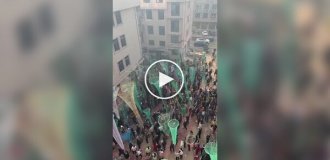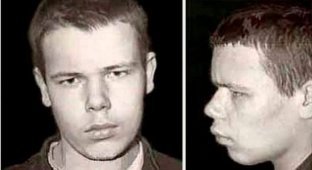Stars are different (12 photos + text)
Thieves' stars with description. I don’t know if it’s necessary, but it’s interesting to read.
Subclavian star of thieves' authority. ITL Cheremkhovo, Irkutsk region. 50s Tattoo of an ardent antagonist, descended from a family of exiled settlers, dispossessed and expelled in the 30s. in the village Irbeyskoye, Krasnoyarsk Territory, where Pronya (the bearer of the tattoo) ended up at the age of five.
In Irbeyskoye, his parents died from overwork and terrible living conditions, after which he ended up in an orphanage in the city of Kansk, from where, in order not to die from hunger and bullying from older pupils, he fled at the age of 13. He settled with relatives in the Zalarinsky district of the Irkutsk region. At this time, someone set fire to a stack of collective farm hay, and Pronya was blamed for everything.
Ending up in a juvenile colony in the village. Thelma, Pronya, this time consciously, firmly took the criminal path, not seeing any other place for herself in the “kingdom of the Jews and communists.”

Subclavian star of thief in law. Copied in the hospital morgue at 54 Lermontovsky Prospekt, St. Petersburg. The authority was killed with a large dose of “raspberry” (barbiturate) in the courtyard of house No. 12 on Shkapina Street while settling camp scores. His identity was established by fingerprints. He turned out to be a certain Mitrofanov, a thief in law, convicted four times for theft. He served his sentence in penitentiary colony No. 5. Meanings of the tattoo: “Everything for me, nothing from me.” “Here, in the zone, I’m at home.”

Tattoo of a repeatedly convicted thief-tourist nicknamed Sultan. Copied at the Almaty city police department. 60s A touring thief nicknamed Sultan, aka Emir of Bukhara, aka Akhmed of Samarkand, “worked”, starting from a minor age, in many cities of Central Asia and by the time of his last arrest had the thieves’ “title” of thief in law; was detained red-handed by the task force in the central department store of Almaty. It is noteworthy that Sultan was identified by an old detective who had previously detained him in Almaty three times. When detained, the Sultan bitterly complained about the “evil fate” pursuing him in this city. Seeing the subclavian stars of the Sultan, which, among other things, have the meaning “Glory to Allah that I am a Muslim”, “There is no God but Allah”, the operative answered the thief: “How can you talk about evil fate, you scoundrel! In the old days, if they caught you stealing and saw such a tattoo, they would immediately cut off your hands, and then your head!”

Subclavian star of the Moscow thief. Leningrad. 50s Zhuk was convicted of theft under Art. 162 of the Criminal Code of the RSFSR of 1926 and were convicted twice according to the Decree of the PVS of the USSR dated 06/04/47. Having arrived at pre-trial detention center No. 1, Zhuk was supposed to proceed further to Vorkutlag. However, wanting to show his “coolness”, during a “shmona” (search) at the commandant’s office, he spat in the face of the guard, for which he was subjected to the “Leninist method of physical persuasion” - a group beating by the guards, after which he was pushed half-dead into an overcrowded cell. Meanings of the tattoo: “For Russia without Jews, Chuchmeks and Marxist-Leninists”, “Under the Tsar, Russians were people.”

Subclavian star of prisoners hostile to the administration of places of detention (“denied”). Copied into ITK-9. Thieves' Russian national tattoo of “thugs”, “denied”, “bulls”, hostile to the authorities of the CPSU and law enforcement agencies. Meanings: “Adolf Hitler is a holy martyr”, “The killing of communists and Jews is not murder, but the cleansing of the world from the messengers of the devil.”

Subclavian star of thieves' authority, "executioner of the zone." ITK of Tulun, Irkutsk region. 50s Tattoo of a thieves' authority nicknamed Skull, who played the role of a "vaidot" in the zone - an executioner and, according to the most approximate data, committed more than ten murders of prisoners, most of whom were so-called "counter-contractors", that is, convicted under "political" articles. This happened after the repeal of Art. 136 of the Criminal Code of the RSFSR of 1926, providing for the death penalty for the murder of a person. The skull belonged to a clan of thieves in the zone, on whose orders he “killed” (killed) prisoners undesirable to the thieves. I was in the Irkutlag, Angarlag and Taishetlag camps. It is noteworthy that, by his own admission. The skull never dreamed of being released. The Skull talked about the murders he committed with a smile, as if it were something big and bright in his life. By the time the tattoo was copied, his total prison term was fourteen years.

Tattoo of an authoritative thief with a penchant for romance. Pre-trial detention center No. 1. 80s. Tattoo of an authoritative repeat thief, convicted three times for theft of state and public property. Tattoo bearer, native of the village of Malo-Vishera district, Novgorod region
Ty, grew up without a father, who drowned “due to drunkenness.” He completed his ten-year education in the OLP of the Arkhangelsk region. He knew the poems of Yesenin and Rubtsov by heart and was fond of reading. Meanings of the tattoo: “I will live while my candle burns,” “I will be happy not on this sinful earth, but in the next world.”

Subclavian star of thieves' authority. "Kemerlag". 50s Tattoo of a thieves' authority nicknamed Vakhmister, from the Altai Cossacks, who at the time of copying the tattoo had been imprisoned for more than 25 years. The sergeant with resentment and anger said that in the 20-30s. in Altai he was tried twice by communist judges, drunkards, womanizers and bribe-takers, “jackals from the poor committee.” They dispossessed and exiled his entire family to Narym. After some time, Vakhmistra’s father’s brother and two mother’s brothers were taken to the NKVD in the village of Kolpashovo, Tomsk region, and no one ever saw them again.

Subclavian star of the zone plowman, thief in law. Copied to the village. Ushakovka, Irkutsk. February 1967. The meanings of the tattoo are deciphered as “Devoted to the clan of thieves until the end of my life”, “Prison is my home”, “In the zone I am the master”, “Everything for me, nothing from me”. In the 40-50s. subclavian stars were very rare; as distinctive signs, they were allowed to be pinned only by large camp authorities in the camps of Eastern Siberia, Primorye and Kolyma. Much later, these peculiar “insignia” began to appear among other thieves in law. This star is one of the tattoos of a hereditary thief who began his criminal career before 1917, having passed through the Kraslag, Taishetlag, Angarlag and Kolyma camps - a thief in law nicknamed Head. While copying the tattoo, Golova admitted that during his stay in the camps he independently came to the conclusion that the power of the CPSU in the country was completely identical with the power of thieves in law in the Gulag.

Subclavian star of thief in law. Copied to the village. Ushakovka, Irkutsk. 1967 Tattoo of an old thief in law nicknamed Kolya the Chinese, an Irkutsk resident who served in the Kolyma and Angarlag camps for more than thirty years, who saw and personally knew the head of Dalstroy Berzin, Pavlov and others. His father, a Chinese by nationality, was a machine gunner in a destroyer battalion and died in the Civil War. By the time they met, thief in law Kolya the Chinese and old thief in law Golova had stopped their criminal activities and were living in the village. Ushakovka, as they put it, with “spent time” - funds that were not confiscated during arrests and searches from criminals and were written off to their “personal accounts” in gratitude for the help provided to prisoners in the camps.

Tattoo of the Pskov thieves' authority nicknamed Orlik. Copied to pre-trial detention center No. 1. 70s. Having been twice previously convicted of burglary, convicted for the third time of hooliganism, Orlik said indignantly that “the cops specially attached a ‘cormorant’ (hooligan article) to him” in order to lower his thief’s authority in the zone. According to Orlik, during his previous imprisonments he spent more than 70 days in a punishment cell (a punishment cell, the days of stay in which usually measure the “coolness” of a particular authority figure). The tattoo has the meaning: “Crush the regime”, “I have never lived happily in this country.”

Subclavian star of thieves' authority. Copied into OLP "Kraslaga". 60s A tattoo of a threatening nature, called “Werewolf”, can be deciphered as “Don’t touch me, otherwise death.” The owner of the tattoo, nicknamed Leshy, believed that in every person, in the depths of his soul, there is a beast; Man is by nature more dangerous than any predator. Leshy did not “share his rights” in the zone, did not belong to any groups, however, in his own words, if necessary, “he could kill anyone.”
























